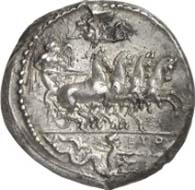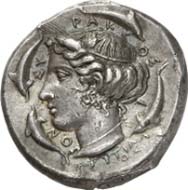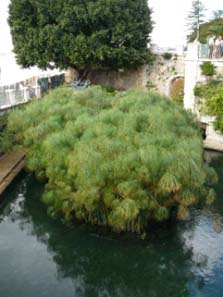80,500 Euros – that was the exact sum paid on October 10 in auction 199 of Gorny & Mosch, Giessener Münzhandlung, for an extraordinary tetradrachm from the Sicilian metropolis Syracuse. Admittedly, that wasn’t a new record, but nevertheless quite a price, which on the same auction outstripped even a dekadrachm of Euainetos, most possibly the most famous die cutter of antiquity. The coin came from one of the most beautiful coin auctions, auction 25 of Bank Leu AG Zurich in 1980. Back then, it obtained roughly 44,500 Euros (according to the current exchange rate) and even back then it put a dekadrachm of Euainetos in the shade.
Syracuse (Sicily). Tetradrachm, c. 415-409 B. C. Quadriga galloping r. whose winged charioteer is crowned by Nike. In the exergue Skylla and the signature EYTH. Rev.: Head of Arethusa surrounded by four dolphins. Below, the artist’s signature PHRYGILL/OS. Tudeer 47; Franke-Hirmer 37. Extremely fine. Final Price: 80,500 Euros.
So, what makes this coin special? Let us first take a look at its obverse with the quadriga led by a charioteer who is approached by a flying Nike about to crown him. When our coin was made, the imagery had just undergone a major change for until then, horses were only shown walking and Nike was crowning the horses. The change dates to about 415 B. C. and marks the beginning of the heyday of the Syracusan art of die cutting. Probably, latest political events provided the background for that change: in 413 B. C., the Syracusans defeated the Athenian fleet and therewith put an end to the so-called Sicilian Expedition, with which Athens wanted to gain an advantage over its ‘archenemy’ Sparta.
The new self-confidence the city had gained after the victory is clearly mirrored in the image on the coin: the quiet walk is replaced by the pace which is rewarded by a victory. In the ancient world a victory was considered a gift of the gods. Some die cutters may have been induced by that to replace the charioteer by a mythological figure in order to avoid catching the gods’ anger because arrogance, hybris, was severely punished, as testified by many myths. Thus, Kore-Persephone, for example, identifiable by her torch, is shown as female charioteer or – as on our coin – Eros, and this apparently was the creation of the designer of the coin’s obverse of whose signature in the exergue only the beginning Euth have been preserved.
It seems that the die cutters’ creativity was unlimited in those days, at least in regard to the details, because Euth… created an entirely new image for the depiction in the exergue as well. Neither Ketos, demon of the sea, nor the dolphins nor the ear as attribute of Kore-Persephone is shown here but Skylla, one of the dreadful creatures that guarded the strait between Sicily and Italy and which Odysseus had to struggle with, too.
Our Skylla, however, doesn’t appear dreadful at all but reaches for a fish, which tries to escape, in an almost playful manner. It doesn’t seem too far fetched to interpret this as reference to the recent naval victory, even more so if Nike held an aphlaston, decoration of the stern, instead of the usual palm branch – this, however, can’t be verified with certainty because of a die error apparently common to all coin of this type.
The fountain of Arethusa in Syracuse can still be marveld at. Photograph: Gunpowder Ma / Wikipedia.
The coin’s reverse was made by the hands of the die cutter Phrygillos whose signature is clearly discernable below the truncation. Phrygillos wasn’t unknown for he was associated with the coinage of the cities of Thuriou and Terina in North Italy and might have worked as gem cutter as well. Hence, he was an experienced artist who re-interpreted the usual depiction of the fountain nymph Arethusa with a wreath made of poppy-seed and ears as Kore-Persephone and therewith created one of the most beautiful heads of late ripe Classical times comparable to the korai of the Erechteion on the Athenian Akropolis in its soft and at the same time severe modelling.
That makes our coin being at the height of its times and may well be considered an important witness of its times: it marks the beginning of a new cultural blossom of the city of Syracuse to be continued far into the 4th century, under the riegn of the tyrant Dionysios.
You will find a full review of the whole Goryn & Mosch auction 199 here.








